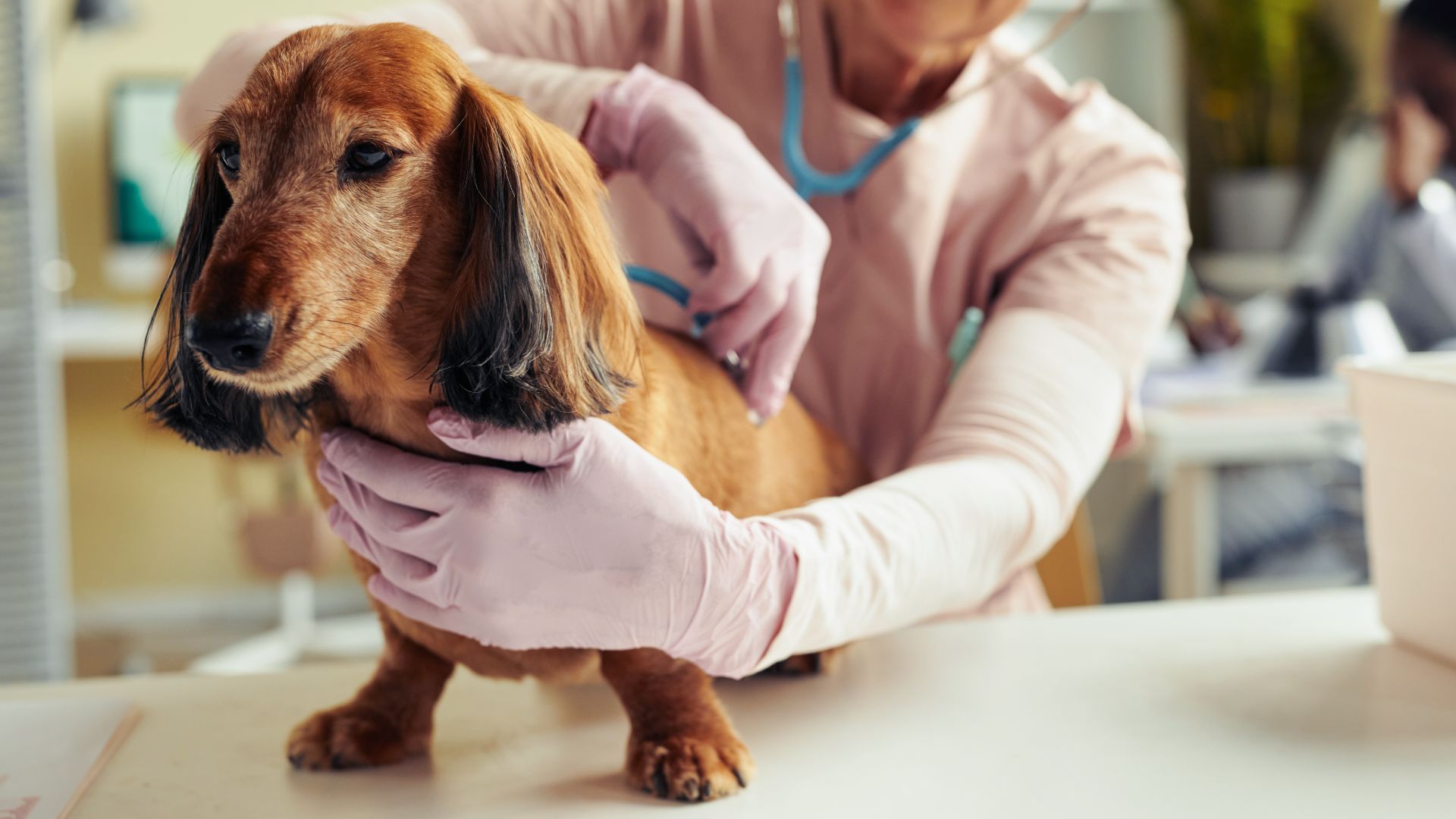
Spotting – and recognizing – the signs a dog is dying is worry-inducing for any owner, especially as none of us want to think about losing a furry family member. Saying goodbye to your beloved pup is likely one of the hardest things you’ll ever have to do. While we all want to have as much time with our dogs as possible, it’s also important to know when to let them go.
Becoming familiar with the signs that your dog could be dying is the key to giving your pup the best possible help. However, it's worth remembering that, in some cases, euthanasia is a kinder option than waiting for your pup to die naturally, especially if they’re in uncontrollable pain.
For more information, check out our guides to signs that your dog is in pain and signs that your dog is getting old or read on to find out the most common signs a dog is dying.
What are the signs a dog is dying?
Not every dog will show the same signs when their life is nearing its end. The signs that they show will vary depending on their individual health issues. Furthermore, the signs a dog is dying go through various stages depending on whether they are weeks, days or a very short time from death.
Here’s a guide to the signs a dog is dying when their death is:
Months away
If a dog is months or weeks from death, they might lose weight, especially muscle, becoming quite thin. Depending on their illness, they might still have a reasonable appetite, but often this will become less over time. Their individual health concerns may worsen, so if they have breathing issues you might notice that their breathing is louder or more labored, or if they have diarrhea this may be more profuse. Dogs who are months or weeks from death may also be more lethargic and subdued, with less interest in going for walks, eating, drinking, playing, or interacting with their owner.
However, it’s important to remember that specific symptoms will vary depending on the dog’s illness, and many dogs who lose weight or go off their food are not dying. Therefore, it’s important to speak to your vet if you’re not sure about your dog’s prognosis.
Days away
In the days before death, dogs will often become very lethargic, spending more time sleeping and less time moving around. By this point, they may have little or no appetite, and it might be a struggle to get them to eat even their favorite foods. A dog may also show:
- reluctance or difficulty standing
- incontinence For example, they do not ask to be let out to the toilet and pass urine or feces where they lie or stand
- no thirst response Dogs with kidney or liver issues often drink excessively, but a dog who is close to dying is unlikely to drink much, if at all
Minutes away
If a dog dies naturally, in the minutes before they pass away you might notice...
- breathing distress Many dogs show changes in their breathing before they pass away. It may become erratic and irregular, they might take some deep gasping breaths, and there may be longer gaps between each breath
- inability to stand or move If they are standing they may collapse, perhaps passing urine or feces. They are unlikely to respond to you talking or touching them, but it doesn’t mean they don’t love you. If they are dying, they may be feeling weak, confused, or in pain, and they might not have the energy to react to you.
- pale gums Their gums may look pale grey, blue, or slightly purple
- cold extremities Your dog may feel cool to the touch, especially in his limbs and lips, which could be a sign your dog’s heart and circulation are struggling
- vocalizations Many dogs will make unusual vocalizations if they are dying. If they are in pain, distressed, or disorientated, they might whine, howl, or yelp. This can be distressing to hear, but your familiar presence will offer your dog some comfort

After death
As a dog passes away, their eyes will become fixed, their pupils dilated, and their breathing will stop, although it’s common for dogs to gasp a little for a few minutes after death, as the muscles relax.
After a dog has passed away, their muscles may twitch for a little while. After a few hours, rigor mortis will set in and their body will become stiff, although this won’t be permanent.
How to help a dying dog
If your dog has been diagnosed with a terminal illness, making a palliative care plan with your vet is the best way to maintain their quality of life.
“Palliative care is the medical and supportive treatment given when an animal is experiencing an incurable illness,” explains companion animal vet Dr Rebecca MacMillan. “It should aim to keep your pet comfortable and give them the best quality of life possible. You will need to make provisions for your pet if they have been given a terminal diagnosis.”
According to Dr MacMillan, ensuring you are as informed as you can be will help you tailor your dog’s care.
“To make a palliative care plan you need to know more about your dog’s condition and what the likely signs and side effects are likely to be,” she continues. “For example, tumors can be very painful for dogs, whereas chronic kidney disease is not painful but likely to make your dog feel nauseous.
Above all, guidance from your vet is paramount.
“Your vet will be key in providing this level of information, but also in being able to prescribe the most effective medications for your pet,” advises Dr MacMillan. “If you have a dog experiencing a terminal illness, then please work alongside your vet. While it can be tempting to seek natural remedies or nutritional supplements, these are unlikely to give your pet the level of support they need.”
Practical measures
While medical considerations are likely top of mind in making a palliative care plan, Dr MacMillan points out that you may need to make some practical changes around the home to help keep your dog comfortable.
“For example, a dog that is unable to walk far too far will need help to get outside to the toilet, or a dog with poor bladder or bowel control will need the owner's patience and plenty of spare bedding.
“However, if you are getting to these sorts of levels of palliative care then you really need to consider whether this is still in your dog’s best interests. If your pet is no longer able to do the things they enjoy doing, such as walking, playing, and eating, or their pain cannot be well managed, then it may be kinder to let them go. Your vet will be able to advise you on euthanasia and discuss when the right time might be.
Knowing when to say goodbye
It’s really hard when the time is approaching to put your dog to sleep. Many pet owners worry about making the decision at the right time – not too soon or too late. You don’t want your pet to suffer but the thought of life without them is hard, so you want to keep them with you as long as possible.
That said, euthanasia is often the kinder option if your pet’s advanced years or medical conditions are preventing them from fulfilling their needs. It’s best to consider how their recent quality of life has been by assessing their appetite, mobility, and any signs of pain.
How many good and bad days?
It’s helpful to take a step back and consider the last couple of weeks – how many good days has your dog had? How many bad days? Are they eating, moving around, and free from pain?
If they’re not eating, have poor mobility, or they’re often in pain, their quality of life is likely to be poor. If they’ve had more bad days than good days it’s likely that they’re beginning to suffer, so it may be kinder to put them to sleep.
Making arrangements
The first step in arranging for your pet to be put to sleep is to call or visit your vet. They’ll be able to help you come to terms with the decision and understand your options.
When exploring your options, you may find that the vet can visit your home to put your dog to sleep. Alternatively, if your dog doesn’t mind the vet – or it’s an emergency and the vet isn’t able to attend – you might have to go to the practice.
If your pet deteriorates suddenly and you’re unable to get them to your usual vet clinic, give the vet a ring. They may be able to visit but, if not, they may know of a mobile vet nearby who can assist.

What happens after canine euthanasia?
After your dog has been put to sleep, the vet team will usually give you some time alone to say goodbye (if you want to). If you’d rather leave then just let them know – everyone has different needs during this time.
How do you arrange dog cremation?
If you’ve decided that cremation is the best option, once you’ve left, the vet and vet nurse will usually wrap your dog in a blanket and move them gently and respectfully to another room in the practice. Then, the paperwork will be completed to ensure that the crematorium knows the type of cremation you have requested. Then, your dog and the paperwork will be placed in cold storage until collection by the crematorium. If you have requested your dog’s ashes back, these are usually returned to the vet clinic, who will let you know as soon as they have arrived.
If you decide that burying your dog at home is the better option for you (check the laws in your area first), the vet team will help you move your dog to your vehicle with dignity and care. Some people choose to plant commemorative plants, keep fur or paw prints, or turn ashes into jewelry.
What do I do if my dog dies at home?
If your dog passes away at home, give your vet a call when you feel able to. They’ll be able to support you, organize cremation, and answer any questions you might have.
Grieving the loss of a pet
Saying goodbye to our furry family members is extremely hard on pet parents and it’s important to remember that there are no rules for how you should feel at a time like this.
It may be helpful to read advice on how to cope with the loss of a pet when you’re ready.







